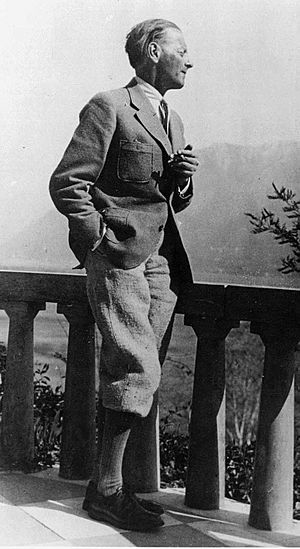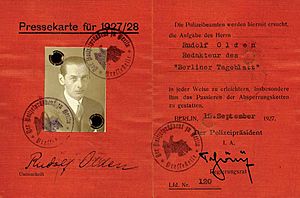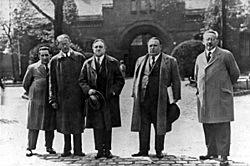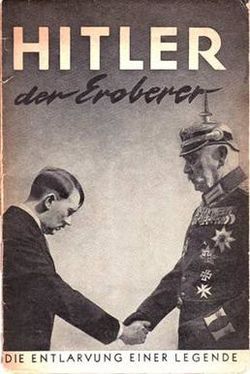Rudolf Olden facts for kids

Rudolf Olden (born January 14, 1885, in Stettin – died September 18, 1940) was an important German lawyer and journalist. During the Weimar Republic (the period in Germany before World War II), he was well-known for his strong opinions in political discussions. He was a fierce opponent of the Nazis and a dedicated supporter of human rights. He was one of the first people to warn the world in 1934 about how the Nazis were treating Jewish people.
Olden wrote a famous book called Hitler der Eroberer. Entlarvung einer Legende ("Hitler the Conqueror, Debunking of a Myth"). This book is considered part of German exile literature, meaning it was written by someone who had to leave their home country. The Nazis quickly banned the book. Soon after it was published, Olden's German citizenship was taken away. He and his wife moved first to the United Kingdom and then, in 1940, to the United States. Sadly, on September 18, 1940, both died when their ship, the SS City of Benares, was attacked by a U-boat in the Atlantic Ocean.
He was a German Liberal of the best sort, rather more pugnacious than the average British Liberal, because he had more to fight against.
—Gilbert Murray, preface to The History of Liberty in Germany, 1946
| Top - 0-9 A B C D E F G H I J K L M N O P Q R S T U V W X Y Z |
Early Life and World War I
Rudolf Olden was born in Stettin, which is now called Szczecin. His father was the author Johann Oppenheim, who later changed his name to Hans Olden. His mother was the actress Rosa Stein. Rudolf was the younger brother of another author, Balder Olden.
After finishing his education, Rudolf decided to join the military. He became part of a cavalry regiment in Darmstadt. During World War I, he was first sent to Belgium. In 1915, he moved to the Eastern Front. Olden survived the war and was a first lieutenant.
A New Path: Journalism and Law
The war deeply affected Olden. After it ended, he left the army. He began a new career as an editor for a peace-focused periodical called Der Friede ("Peace") in Vienna. He also worked for Der Neue Tag.
In 1920, he married Marie-Christine Fournier, who was a psychoanalyst. Through her, he met many journalists and writers. After Der Neue Tag closed, he started his own magazine.
Joining the Berliner Tageblatt
In 1926, Theodor Wolff, who published the liberal newspaper Berliner Tageblatt, asked Olden to come to Berlin. Olden's articles quickly became very popular and sometimes caused a stir. He soon became the Editor in Chief. He also wrote for other publications like Die Menschenrechte ("Human Rights") and Die Weltbühne ("The Global Stage").
In the same year, Olden also became a lawyer and practiced law for several years. In 1931, he joined the board of the Deutsche Liga für Menschenrechte ("German League for Human Rights").
Defending Carl von Ossietzky
In 1931, Rudolf Olden defended Carl von Ossietzky in court. Von Ossietzky was accused of insulting the German army (the Reichswehr). This was because he published an article that included the phrase "soldiers are murderers". Olden's defense was successful, and Von Ossietzky was found not guilty.
In 1933, Olden spoke to a group of German authors. He invited them to a meeting called Das Freie Wort ("The Free Word") at the Kroll Opera House. This meeting was held to protest against the growing pressure on artistic, journalistic, and academic freedoms in Germany. One thousand five hundred artists, authors, scientists, and politicians attended. It was the last major protest organized by liberal, social democratic, and communist parties until 1945.
Life in Exile from Nazi Germany
After the Reichstag fire in 1933, Olden was warned that he was in danger. He barely escaped being arrested by the SS (a Nazi organization). He hid with friends for a night and then traveled to the mountains. He crossed the border into Czechoslovakia on skis. The next day, his future wife, Ika Halpern, joined him in Prague. There, he anonymously published an early version of his book Hitler der Eroberer.
From Prague, they went to Paris. In Paris, Olden published an important book called Schwarzbuch über die Lage der Juden in Deutschland ("Black Book on the Situation of the Jews in Germany"). In this book, he warned the world about the terrible things already happening to Jewish people in Germany. He also worked as an editor for a newspaper in Saarbrücken and spoke out against the Saarland rejoining Nazi Germany.
During this time, Olden could only publish his writings in a few magazines for exiles. These included Das neue Tage-Buch and Die Sammlung. Because of these articles, the diplomat Gilbert Murray invited him to give lectures on German history and politics in Oxford and London. Olden gladly accepted. He and Ika stayed with the Murrays in a small house on their property.
Supporting Fellow Exiles
In 1934, Olden became the unofficial secretary of the German P.E.N. chapter for exiles. Even though he was never formally chosen, he worked very hard. He helped authors who had to flee Germany, like Thomas Mann, by providing visas, contacts, and financial help.
In 1935, a longer version of his book, Hitler der Eroberer, was published in Amsterdam. In 1936, the book was published in English as Hitler the Pawn. His younger half-brother, Peter Hans Olden, who became a U.S. citizen, helped him with the book.
In 1936, Olden's German citizenship was taken away. He continued his work with the P.E.N. in London. He also worked to convince the Nobel Committee to give the Nobel Peace Prize to Carl von Ossietzky, who was imprisoned by the Nazis.
Final Journey
In 1939, when World War II began, Olden was interned (held in a camp) and became ill. During this time, he accepted an invitation to lecture at the New School of Social Research in New York City. Earlier, he and Ika had sent their daughter, Mary Elizabeth, to Canada on a special transport for children.
When Olden boarded the SS City of Benares, his passport was stamped with the words "No Return." On September 18, 1940, the City of Benares was part of a convoy when it was torpedoed by the German submarine U-48. Tragically, 258 people died, including 81 of 100 British children who were being evacuated to Canada.
Rudolf Olden died at age 55, along with Ika Halpern, whom he had married in London. She was 35. A witness remembered that Ika had been encouraged to get into a lifeboat by another passenger, but she wanted to stay with her unwell husband. Eventually, her friend, Professor John Percival Day (who survived), convinced her to enter a lifeboat. However, she died when the boat tipped as it was being lowered, sending her into the sea.
Later, Nazi German propaganda falsely claimed that Olden was traveling to persuade the United States, which was neutral at the time, to join the war.
A memorial to Rudolf Olden was placed at Balliol College, Oxford, on the east wall of the Chapel passage.




